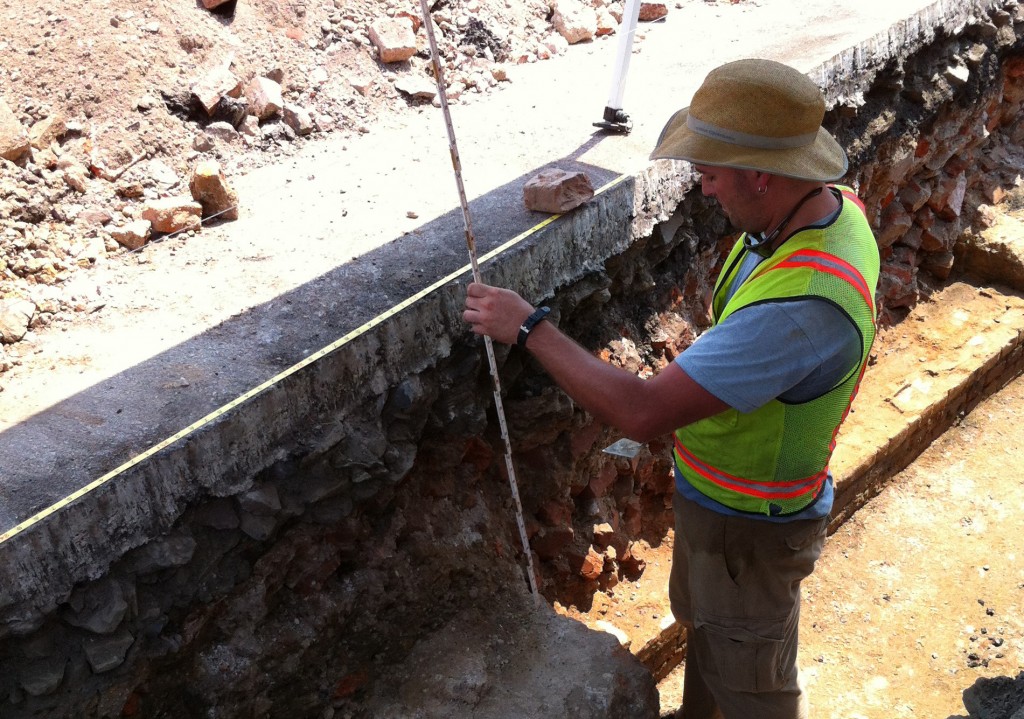Reporting Archaeology
Back to PAF Home
Back to Archaeological Research in Philadelphia

An archaeologist from the firm of John Milner & Assoc. records information at the site of the historic West Shipyard.
This research excavation was undertaken by the Delaware River Waterfront Corporation. (Photo by PL Jeppson, 2012)
Research at an archaeology site produces one, and sometimes many, archaeological reports. These reports are of various kinds, depending on who undertakes the research, who pays for the research, and where the researched site is located. The type of report also depends on when the work was done. Philadelphia’s history of archaeological research extends deep into the past and therefore it reflects the evolution in archaeological site reporting that has occurred over time. Early reports were often made by professionals not trained in archaeology (and archaeology’s own standards of practice were themselves elaborating).
For the past few decades, most (but not all) of the archaeological research conducted in Philadelphia was undertaken in response to federal, state, and or municipal legislation (for example, the Antiquities Act, state laws, city codes, and or City of Philadelphia operations as a Certified Local Government). This type of archaeological research, known as cultural resources management or compliance archaeology, is ‘triggered’ whenever public (or government) monies are expended or when government actions might lead to impacts on the archaeological resources on public (common) lands. This archaeological research is sometimes undertaken by archaeologists working for the government agency in question (for example, the National Park Service) but more commonly this work is conducted by commercial archaeological concerns that are hired under contract by the government entity.
In this compliance (legislatively required) -type of archaeology, the work is reported on stage-by-stage. Phase I reports present historical background research and assessments of archaeological potential for a particular site; they may also present findings from preliminary excavation testing. Phase II reports document the findings from preliminary excavations of a site, and also present a researcher’s recommendations for conducting more intensive Phase III investigations. Phase III reports summarize the entire archaeological history of the project and present the findings that result from the later-stage, large-scale, intensive, “data recovery” phases of the excavation. Given that this is work conducted on behalf of the public by their government concerns (federal, state, or national), these reports and the research findings belong to the public and are accessible. The one exception is that specific archaeological site locational information is often retracted in order to protect the public’s archaeological heritage.
The reporting is similar when it comes to documenting archaeology taking place on private lands. With the exception of certain kinds of burials and prehistoric and historical cemeteries, there are no archaeological protections that apply to private land in the U.S. and therefore no legislatively required reporting. Archaeologists who excavate on private land generally are pursuing an elective scientific inquiry. They gain permission from the land owner and make an agreement regarding the site reporting. Ethical standards of archaeological practice include the formal reporting of research findings.
Archaeological site documentation includes research design plans, budgets, permissions, preliminary background research, photo logs, field drawings, photographs, maps, daily field notes, artifact bag catalogs, artifact inventories, 3D scans, final reports, and more. All archaeological site records and artifacts recovered from public lands are archived in perpetuity at a designated repository (e.g., the Pennsylvania State Museum, The History Museum of Philadelphia, or Independence National Historical Park). Ethical standards of practice lead archaeologists working on private lands to archive all available materials (e.g., field notes, reports, etc.) whenever possible in a suitable location (e.g., at the Anthropology Lab at Temple University, at a local museum, at the American Philosophical Society library).
A brief history of Archaeological Research in Philadelphia
A short description of the Archaeological Research Process
by admin
